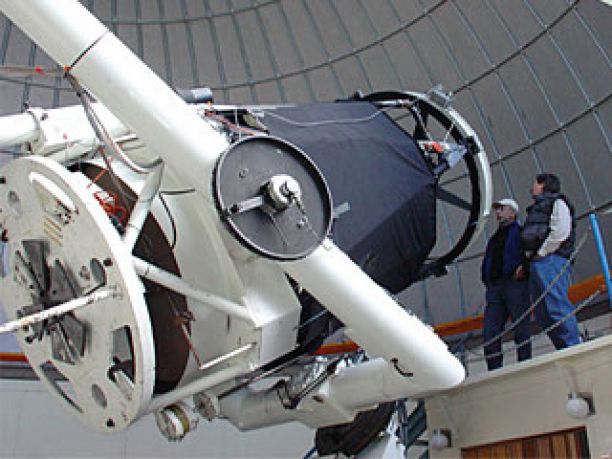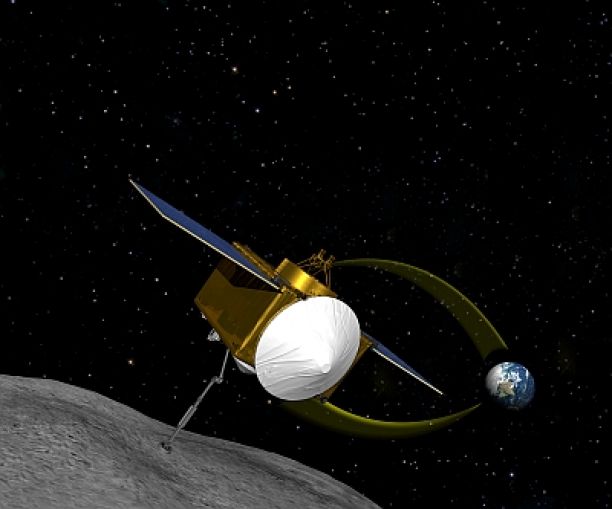June 30, 2013
In line with NASA's recently issued "Asteroid Grand Challenge," the UA is at the forefront of discovering and tracking space rocks, engaging the global community in the effort and is poised to send a spacecraft to a potentially hazardous asteroid to bring a sample back to Earth.
NASA has issued an “Asteroid Grand Challenge” focused on finding all asteroids that could present a threat to Earth.
The initiative, aimed at partners in national and international government, industry, academia and with citizen scientists, includes the University of Arizona with its unsurpassed track record in asteroid hunting, a citizen science asteroid program recently awarded with a White House award and leadership in the first NASA mission to return a sample from a potentially hazardous asteroid.

Operating several telescopes in the Northern and Southern Hemispheres, the UA Catalina Sky Survey has discovered more asteroids than any other such program. Shown here is the 60-inch telescope atop Mt. Lemmon just north of Tucson, Ariz. (Photo: Catalina Sky Survey)
When it comes to potentially hazardous asteroids, NASA officials say, mankind is well advised to sweat the small stuff.
While scientists say that 95 percent of asteroids larger than one kilometer have been discovered, countless small, difficult-to-spot space rocks are whirling through space, with an unknown number possibly tumbling along a collision course with Earth.
The fireball that blew up over Chelyabinsk in Russia in February 2013 served as a reminder that even a house-sized object can unleash a blast capable of injuring about 1,500 people – in this case, mostly from shattered glass caused by the air blast – if it goes undetected until it plunges into the Earth’s atmosphere.
In addition to high-tech detection methods and developing a spacecraft capable of rendezvousing with an asteroid in deep space, UA researchers also pursue programs that aid in the hunt for the next threat and enlist citizen scientists in characterizing asteroids.
The UA’s Catalina Sky Survey remains the most productive asteroid-discovery program operating today, finding new near-Earth objects at a rate of around 600 per year. NASA’s Near Earth Object (NEO) Program lists the Catalina Sky Survey as “currently the most efficient NEO survey program for finding new near-Earth objects.”
“Nobody has discovered more asteroids than we have,” said Tim Swindle, head of the UA’s Department of Planetary Sciences in the College of Science, referring to Spacewatch and the Catalina Sky Survey, both programs created at the UA to find and track asteroids that could pose a threat to Earth. “As far as asteroids go, we are the university that does asteroids more than anybody else.”
The Catalina Sky Survey is also the most sensitive survey for finding small near-Earth asteroids in the 15 to 30-foot size range, which are candidate targets for NASA’s Asteroid Redirect Mission (ARM), according to Eric Christensen, the Survey’s newly appointed principal investigator.
Christensen said ARM targets – small asteroids in Earth-like orbits – are difficult to discover due to their small size and the fact that they are only “discoverable” for as little as a few days before they fade.
“The current rate of discovery for these kinds of objects is too low to find enough good candidates for ARM mission planning” Christensen explained. “It needs to increase by a factor of at least 10 to support such a mission. The Catalina Sky Survey is currently in the midst of upgrades to both of our survey telescopes on Mt. Lemmon, which will increase their overall capability and their sensitivity to ARM candidate targets.”
“As we keep getting better at finding these things, we discover that such close approaches happen more frequently than you might think,” said Ed Beshore, former director of the Catalina Sky Survey, about object 2012 DA14, better known as the “Valentine asteroid,” which buzzed the Earth on February 15 at a distance of about 17,200 miles or 27,680 kilometers, closer than geostationary satellite orbit.

NASA has tasked the UA with leading the OSIRIS-REx mission, slated to rendezvous with asteroid Bennu and return a sample to Earth in 2023. (Illustration: NASA/GSFC/UA)
Even before NASA rolled out its new initiative to involve creative minds to ramp up the search for hazardous asteroids, Dolores Hill and Carl Hergenrother of the UA Lunar and Planetary Laboratory began the citizen science program called Target Asteroids! as part of the OSIRIS-REx Education and Public Outreach program in 2011.
Target Asteroids! is aimed at engaging amateur astronomers in studying asteroid targets for future missions and at increasing our knowledge of the near-Earth asteroid population.
To that end, volunteer observers track asteroids over time, measure their brightness and gather clues about their shape, spin and composition. In the program's first year alone, 138 amateurs registered from 25 states and 26 countries and provided 87 data sets on 17 near-Earth asteroids.
Some use custom-made, often automated telescopes equipped with CCD cameras in their backyards. Others use home computers to make remote observations with more powerful telescopes states or continents away. Many belong to leading national and international amateur astronomy organizations with members ranging from retirees to school kids.
“The Target Asteroids! program provides an opportunity for amateur astronomers to track a special list of near-Earth asteroids important to the OSIRIS-REx mission and future sample return missions,” said Dolores Hill, who was recognized as one of 12 White House Champions of Change for citizen science for coming up with the concept.
“In the case of the Russian meteor for example, the asteroid came from the glare of the sun and could not be detected by large observatories,” Hill said. “It could have been detected farther out in its orbit if the right telescope was looking at the right place and the right time.”
“We look forward to expanding the Target Asteroids! list to support NASA's Grand Challenge by including targets for a manned mission and the redirection of an asteroid.”
“The next step in asteroid research is figuring how to get to an asteroid, how to maneuver around it, and find out more about it by bringing a sample back to Earth,” said Swindle. “That is what we’ll take on with the OSIRIS-REx mission. We are in many ways the big player in figuring out how to deal with this.” Swindle went on to say that OSIRIS-REx will lead to a greater understanding of the forces that cause asteroids to become collision threats with the Earth.
OSIRIS-REx, led by the UA, is NASA’s mission to send a spacecraft to return a sample from asteroid Bennu, one of several known asteroids that occasionally come dangerously close to Earth. Bennu is believed to be a primitive object, created shortly after the formation of the solar system more than 4.5 billion years ago. Earth-based studies of the sample should yield valuable clues about the chemistry that led to the origin of life on Earth.
OSIRIS-REx is led by UA planetary science professor and principal investigator Dante Lauretta, along with Ed Beshore as the project’s deputy principal investigator. In preparation for its 2018 encounter the UA has carefully selected Bennu, the OSIRIS-REx target asteroid, for maximum scientific value. Hergenrother, along with other scientists on the OSIRIS-REx team, has conducted extensive multi-year studies of that asteroid using ground- and space-based telescopes. All of this effort has resulted in a spacecraft and instrument suite that has a high probability of success.















